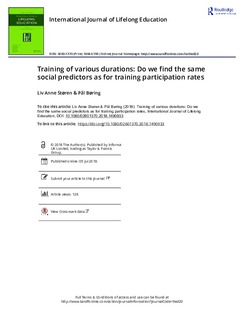Training of various durations: Do we find the same social predictors as for training participation rates
Journal article, Peer reviewed
Published version

Åpne
Permanent lenke
http://hdl.handle.net/11250/2566891Utgivelsesdato
2018Metadata
Vis full innførselSamlinger
Originalversjon
10.1080/02601370.2018.1490933Sammendrag
Most studies on participation in training focus on participation versus non-participation. The individual’s participation varies, however, very much in terms of the duration of training, from until a few days to intensive participation. This study examines participation in non-formal training by the total amount of training during a year. In the analysis, we use PIAAC data for eight European countries, of which half represents a group of countries with high participation rates in non-formal training and the other half have lower participation rates. One purpose is to examine whether the duration of training varies between these groups of countries. We expected that countries which score high on training rates are characterised by high proportions participating in short courses. Another purpose is to examine the relationship between duration of training and educational levels and immigrant backgrounds. We expected that the relationship that is normally found between training rates and social background variables would be reversed when it comes to duration of training. In the analyses, controls are applied for several individual and workplace characteristics, including skills level, firm size, occupational level, and industrial sector. The estimation results indicate that overall, our expectations are not supported.
